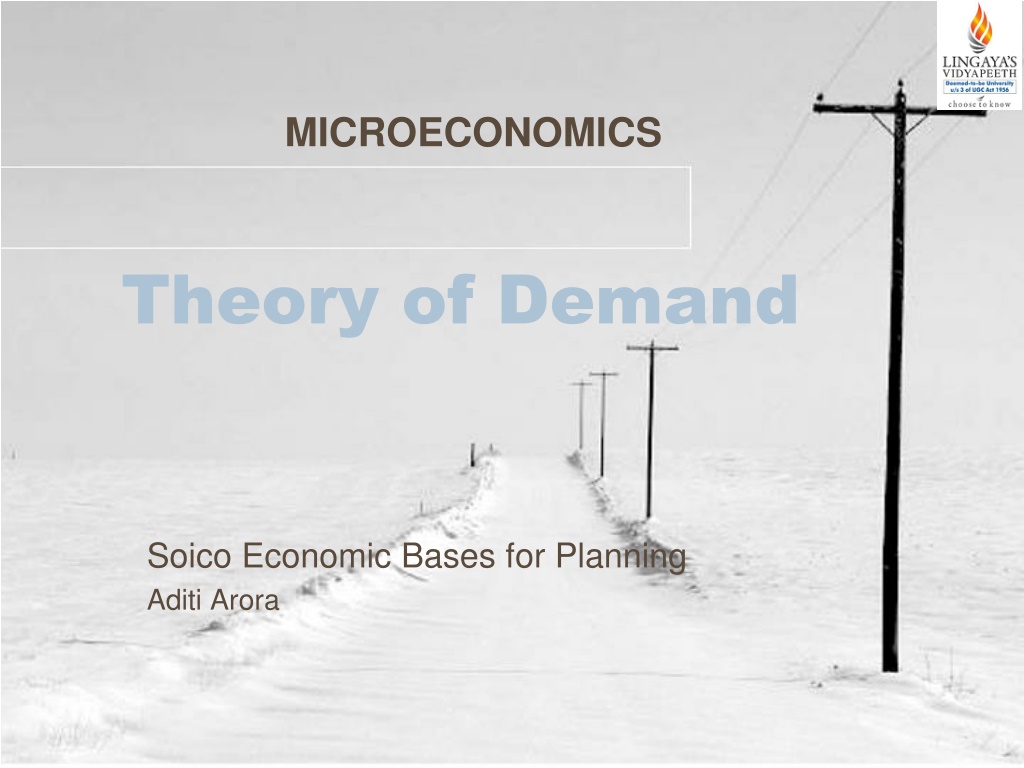Understanding the Theory of Demand in Microeconomics
The theory of demand in microeconomics explores the concept of consumer willingness and ability to purchase goods and services at various prices. Factors influencing demand include price, related commodity prices, income levels, consumer preferences, population size, and distribution of income. The law of demand states that there is an inverse relationship between price and quantity demanded. However, exceptions to this law exist, such as with conspicuous goods, Giffen goods, and hoarding behavior.
Download Presentation

Please find below an Image/Link to download the presentation.
The content on the website is provided AS IS for your information and personal use only. It may not be sold, licensed, or shared on other websites without obtaining consent from the author. Download presentation by click this link. If you encounter any issues during the download, it is possible that the publisher has removed the file from their server.
E N D
Presentation Transcript
MICROECONOMICS Theory of Demand Soico Economic Bases for Planning Aditi Arora
Demand The concept demand refers to the quantity of a good or service that consumers are willing and able to purchase at various prices during a period of time. It is more than a desire to purchase: needs to be backed by purchasing power/ ability to pay ; that is effective demand Effective demand depends on (i) desire (ii) means to purchase and (iii) willingness to use those means for that purchase Quantity demanded is always expressed at a given price as price change, so does demand
Determinants of demand Price of the commodity Prices of other related commodities Substitutes tea and coffee Complements tea and sugar Level of income budget constraint Tastes and preferences of the consumer Size and composition of the population Distribution of income
Demand Function Qd = f (Pc, Pr, Y, T, D) ceteris paribus Pc - Rise in price Pr - Rise in price of related items Y - Level of income Exception inferior goods i.e. basic necessities T - Taste and preference Goods in fashion mobiles, tablets, ipads etc demonstration effect D - Other factors size of population, composition of population, distribution of income
Law of Demand Other things being equal, if the price of a commodity falls, the quantity demanded will rise and vice-versa Inverse relationship between price and quantity demanded, other things remaining same Drawing a Demand curve for an individual Market demand curve
Law of Demand Rationale for the law of demand When price falls the good becomes relatively cheaper substitution effect Consumer s purchasing power increases as s/he is able to buy more of the good at the same price income effect Entry of more buyers in the market due to price fall
Exceptions to the Law of Demand Conspicuous goods higher price increases the prestige value of the good antique goods, paintings Giffen goods inferior goods that occupy substantial place in consumer s budget e.g. as price of bread increased, British workers purchased more of it Future expectations about prices hoarding of grains during droughts Impulsive purchases Ignorance effect
Movement along the DD curve Other things remaining constant, if there is a change in the price, quantity demanded changes What about shift of the DD curve?
Shift of the Demand Curve Change in income Change in prices of other goods substitutes and complementary goods Change in tastes Change in population
Elasticity of Demand Defined as the responsiveness of the quantity demanded of a good to changes in one of the variables on which demand depends Price elasticity = Ep = % change in quantity demanded % change in price Change in quantity Original quantity = Change in price Original price X 100 X 100 The numerical value of elasticity of demand can assume any value between 0 and infinity ( ) We ignore the negative sign and take the absolute value of elasticity for convenience
Price elasticity of demand Value of elasticity Description Terminology Example of goods E = 0 Quantity demanded does not change as price changes Completely inelastic Salt/ life saving drugs 0 < E < 1 Quantity demanded changes by a smaller % than the price change Inelastic Wheat/ Rice E = 1 Quantity demanded changes by exactly the same % as the price change Unit elasticity
Price elasticity of demand Value of elasticity Description Terminology Example of goods 1 < E < Quantity demanded changes by a larger % than the price change Elastic Clothes, TV etc E Purchasers are prepared to buy all they can at some price and none at all Perfectly elastic
Determinants of price elasticity Availability of substitutes goods with close substitutes have high price elasticity. i.e. tea/ coffee; vegetables are inelastic Position of a commodity in the consumer s budget greater the proportion of income spent on a commodity greater is its elasticity Nature of need luxury goods are price elastic while necessities are price inelastic Consumer habits addiction is inelastic























